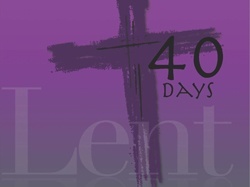
Living Lent in its fullness
Monday, March 5, 2012
*Peter Ductram
The term Lent comes from Lenten, an old English word that means spring; while Cuaresma, in Spanish, comes from the Latin word Quadragesima which means 40 days. Lent is a joyous season as we await the great day of Easter.

Other Lenten resources:
- Your Guide to Catholic Lent, Our Sunday Visitor
- We Believe and Share: Resources for Lent, Sadlier
- Lent Resources, Loyola Press
- Six Ways to Evangelize During Lent, USCCB
In these 40 days we take a moment to evaluate our journey of faith. It is truly joyous because we come to accompany the catechumens as they discern through the Rite of Christian Initiation of Adults on their radical desire to welcome the gift of baptism. Even our liturgical celebrations become enriched with symbols that aim to bring us to contemplation of the Lord calling us to conversion. It is also the time that we are encouraged as we witness our children coming to the sacrament of Penance for the first time. You may also have noticed that we do not celebrate the sacrament of baptism, except in danger of death.
Lent is in essence a desert experience with Christ, a time of prayer and fasting so we may be ready to be submerged again, with the elect, into the waters of baptism.
The Church teaches us three ancient pillars and interrelated practices that remain as rich and life-giving today as they were in the early Christian communities. The three ancient penitential practices are alms-giving, prayer and fasting:
- Alms-giving reminds us that sharing should be the mark of our daily lives as Christians. It corrects our relationship to the poor and less fortunate. It opens our eyes, hearts and hands to share joyfully the gifts we have received, sharing time, talents and treasure.
- Prayer strengthens our relationship with God who speaks to us and desires to draw us to himself. Prayer aligns our relationship with God and with our brothers and sisters.
- Fasting helps correct our relationship with ourselves. It is more than giving up something we love to do, it’s a healthy discipline that is richer when we do it within our domestic church, our families; a discipline that aims to fall in love with Christ again and begin new life in him.
Here are some practical ways to practice all three:
In the Gospel according to Matthew, Jesus says: “When you give alms, do not blow a trumpet before you...When you pray, go to your inner room, close the door, and pray to your Father in secret. When you fast, do not look gloomy... But when you fast, anoint your head and wash your face, so that you may not appear to be fasting...”
This reminds us that we prepare ourselves in Lent, and do alms-giving, prayer and fasting, not for the sake of communal acknowledgement but as a personal renewal within the community of faith. Lent requires silence that permeates the soul and allows us to contemplate our loving God.
So this Lent, let us practice these spiritual traditions. Here are a couple of suggestions:
Let us reach out to others through alms-giving. A concrete example is to support our archdiocese through the Archbishop’s Charities and Development Drive (ABCD) that supports the concrete and great work of our local Church and its many ministries.
Witness a life transformed by prayer. Through prayer, let us open our hearts to God and talk to God more often so our relationship with God blossoms. A concrete way to do that is by taking advantage of:
Also, abstinence from meat is to be observed by all Catholics 14 years old and older on Ash Wednesday and all the Fridays of Lent.
Lent ends on Holy Thursday, the beginning of the Paschal Triduum, as the Church begins the Mass of the Lord’s Supper.
Do you have any other practical ideas for alms-giving, prayer and fasting? Share with us how you live Lent in its fullness! Let us pray that in silence may we contemplate the wondrous acts of God in all of us!
This reminds us that we prepare ourselves in Lent, and do alms-giving, prayer and fasting, not for the sake of communal acknowledgement but as a personal renewal within the community of faith. Lent requires silence that permeates the soul and allows us to contemplate our loving God.
So this Lent, let us practice these spiritual traditions. Here are a couple of suggestions:
Let us reach out to others through alms-giving. A concrete example is to support our archdiocese through the Archbishop’s Charities and Development Drive (ABCD) that supports the concrete and great work of our local Church and its many ministries.
Witness a life transformed by prayer. Through prayer, let us open our hearts to God and talk to God more often so our relationship with God blossoms. A concrete way to do that is by taking advantage of:
- - Loyola Press’ "3 Minutes for Lent" on Facebook. Taking off from its very popular “3-Minute Retreat” feature, this leads people through a brief series of meditations on a variety of Scripture passages with some peaceful music.
- - Upcoming Lenten retreats for catechists, ministers and catechetical leaders sponsored by the Office of Catechesis.
Also, abstinence from meat is to be observed by all Catholics 14 years old and older on Ash Wednesday and all the Fridays of Lent.
Lent ends on Holy Thursday, the beginning of the Paschal Triduum, as the Church begins the Mass of the Lord’s Supper.
Do you have any other practical ideas for alms-giving, prayer and fasting? Share with us how you live Lent in its fullness! Let us pray that in silence may we contemplate the wondrous acts of God in all of us!


Comments from readers
She commented to me how many wonderful moments she experienced with other people because of "the loaf of bread."
God had a lesson for us. Share your bread with the hungry. A meal is meant to be eaten with others. We are social beings.
That is a "practical" way of practicing Lent. Step outside of yourself!
Vivian Cuadras